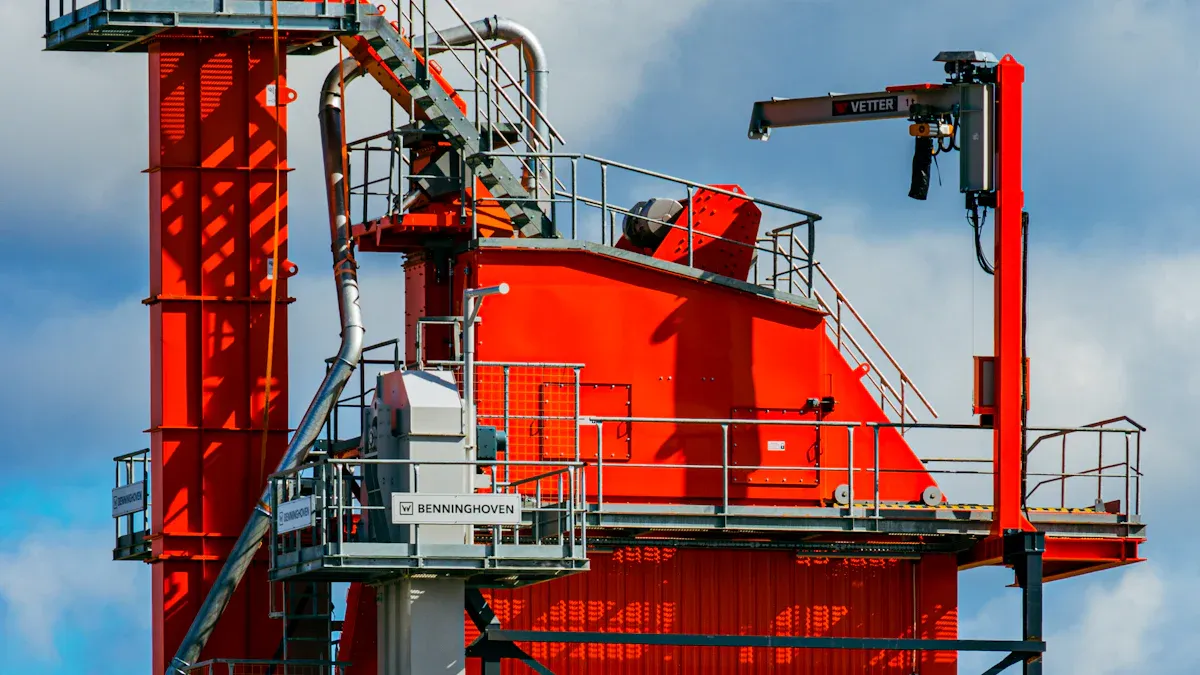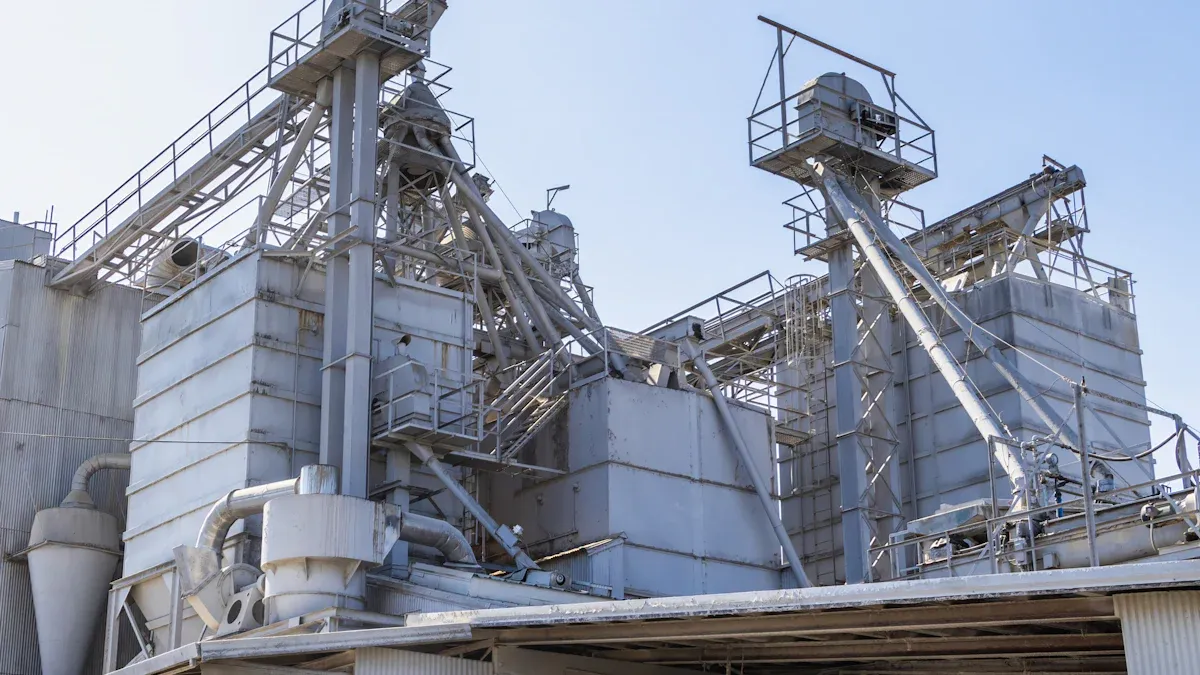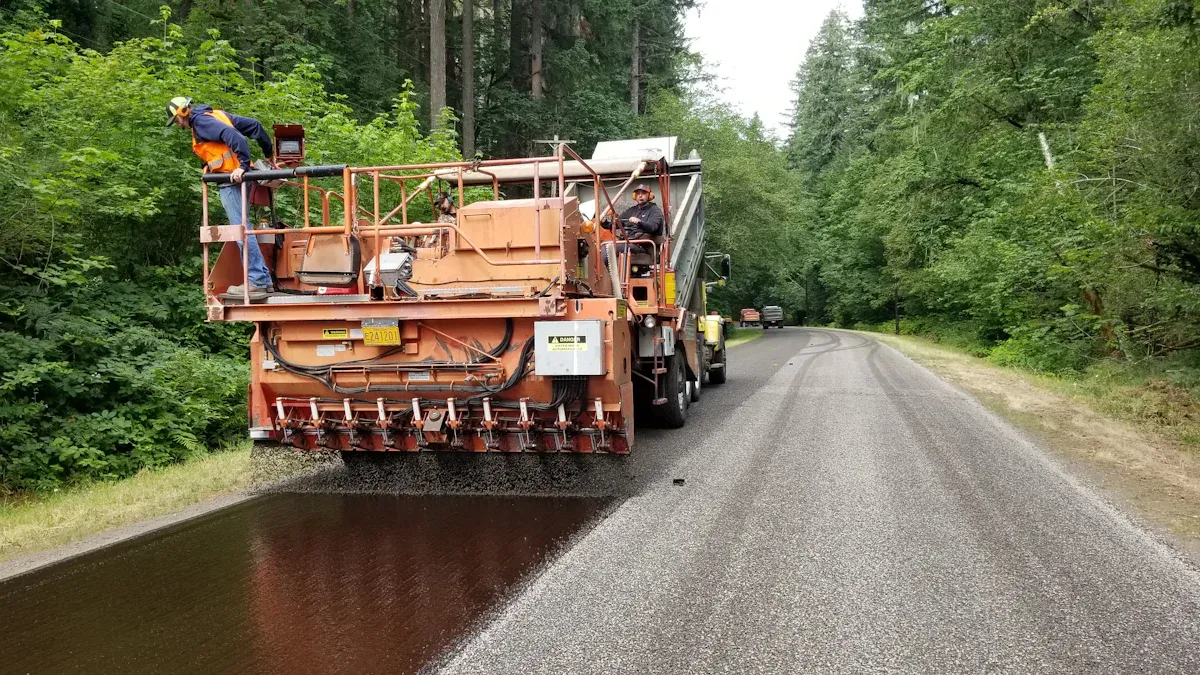
Asphalt mixing plant arms play a vital role in producing high-quality asphalt. These components are responsible for blending raw materials like aggregates, bitumen, and fillers into a consistent mixture. You rely on them to ensure the mixing process is both efficient and uniform. Without them, achieving the required texture and durability in asphalt would be challenging. Their precise design allows you to produce asphalt that meets industry standards, ensuring strong, long-lasting roads and structures.
Asphalt mixing plant arms are specialized tools designed to blend raw materials into a uniform asphalt mixture. These arms operate within the mixing drum of an asphalt mixing plant, ensuring that aggregates, bitumen, and fillers combine seamlessly. Their primary purpose is to create a consistent mixture that meets industry standards for strength, durability, and flexibility. Without these arms, the mixing process would lack precision, leading to uneven asphalt that compromises the quality of roads and structures.
You can think of these arms as the "hands" of the mixing plant, tirelessly working to achieve the perfect balance of materials. Their design focuses on efficiency, enabling faster production while maintaining high-quality results. By optimizing the mixing process, these arms play a crucial role in reducing energy consumption and minimizing waste, aligning with modern industry goals for sustainability and performance.
Tip: High-quality mixing arms not only improve asphalt production but also reduce maintenance needs, saving you time and money in the long run.
Each component of the asphalt mixing plant arms contributes to the overall efficiency of the mixing process. The arms themselves are typically made of durable, anti-wear materials to withstand the abrasive nature of aggregates and the high temperatures of bitumen. Their design includes paddles or blades that rotate within the drum, ensuring thorough mixing and preventing material buildup.
Here’s a closer look at the key components involved in asphalt mixing:
| Component | Role in Asphalt Mixing Process |
|---|---|
| Bitumen | Acts as the binding agent, holding aggregates together and providing flexibility and waterproofing. |
| Aggregates | Make up the bulk of the asphalt mixture, providing strength and stability. |
| Gravel | Serves as the backbone of the mixture, supporting heavy loads and enhancing durability. |
| Sand | Fills gaps between larger aggregates, ensuring the mixture is compact and smooth. |
| Crushed Stone | Adds extra strength and durability to the final product. |
The arms work in harmony with these components, ensuring that each material is evenly distributed throughout the mixture. This uniformity is essential for producing asphalt that can withstand heavy traffic and harsh weather conditions.
Note: Innovations in asphalt mixing plant technology, such as improved insulation and continuous monitoring systems, further enhance the performance of mixing arms. These advancements reduce energy consumption and improve product quality, making them a valuable investment for any asphalt production facility.

The mixing process in an asphalt mixing plant revolves around the efficient blending of raw materials to create a uniform asphalt mixture. The mixing arms play a central role in this operation. Positioned within the mixing drum or pugmill, these arms rotate at precise speeds to ensure that aggregates, bitumen, and fillers combine thoroughly.
The design of the mixing arms, including their length, angle, and the number of blades, directly impacts the quality of the mixture. For example, in a pugmill, the arms rotate at approximately 33.6 rpm, creating a shear rate of 165,400 1/s. This high shear rate ensures that even the smallest particles are evenly distributed, resulting in a consistent mixture. In contrast, a continuous mix plant operates at a slower speed of 7.68 rpm, with a drum radius of 1.69 meters, achieving a shear rate of 135,200 1/s.
| Parameter | Value |
|---|---|
| Shear Rate | Maximum shear rates during mixing are critical for understanding the mixing process. |
| Continuous Mix Plant Speed | 7.68 rpm (0.8 rad/s) for the Astec plant with a drum radius of 1.69 m. |
| Pugmill Speed | 33.6 rpm (3.52 rad/s) with mixing arms length of 0.47 m. |
| Instantaneous Shear Rate | Estimated at 165,400 1/s for pugmill and 135,200 1/s for drum plant. |
The mixing arms also ensure that the mixing time is sufficient to achieve the desired consistency. Asphalt mixing pots, for instance, feature more arms and blades than those used for cement mixtures. This design allows for faster and more effective mixing, which not only improves productivity but also reduces energy consumption over time.
Tip: Regularly monitor the speed and alignment of the mixing arms to maintain optimal performance and prevent uneven mixing.
Uniformity and consistency are critical for producing high-quality asphalt. The mixing arms ensure that every particle of aggregate is coated with bitumen, creating a smooth and durable mixture. Their strategic placement and movement within the drum or pugmill prevent material buildup, which could otherwise lead to uneven mixing.
The effectiveness of the mixing arms can be seen in performance tests like the Balanced Mix Design (BMD). These tests evaluate factors such as rutting resistance, cracking resistance, and moisture susceptibility. By ensuring that the materials are evenly distributed, the mixing arms help asphalt mixtures perform well under these tests.
Balanced Mix Design (BMD):
Evaluates rutting resistance, cracking resistance, and moisture susceptibility.
Uses Performance Space Diagrams (PSDs) to chart results from multiple tests.
Helps identify performance zones for different mix factors.
Case studies also highlight the importance of mixing arms in achieving superior asphalt quality. For example, mixtures with 3% hybrid asphalt content showed the highest moisture resistance, while those with 6% content demonstrated enhanced tensile strength. These results confirm that the precise operation of mixing arms directly impacts the performance of the final product.
| Hybrid Asphalt Content (%) | ITR Value | Performance Description |
|---|---|---|
| 0 | Below 80 | Control mixture |
| 3 | Highest | Superior moisture resistance |
| 6 | Improved | Enhanced tensile strength |
| 9 | Lower | Decline in performance |
By maintaining uniformity and consistency, the mixing arms ensure that the asphalt can withstand heavy traffic and harsh weather conditions. This reliability makes them an indispensable component of any asphalt mixing plant.
Note: Upgrading to high-quality mixing arms can significantly improve the uniformity of your asphalt mixtures, leading to better performance and longer-lasting roads.
High-quality asphalt mixing plant arms significantly improve the efficiency of the mixing process. These arms ensure that raw materials, such as aggregates and bitumen, are blended quickly and thoroughly. This reduces the time required to achieve a uniform mixture, allowing you to produce asphalt faster without compromising quality.
Modern asphalt mixing plants incorporate advanced features that enhance efficiency even further. For example:
- Four-bin cold aggregate feeders with variable speed drives ensure precise material flow.
- Vibratory screens remove oversized particles, preventing disruptions during mixing.
- Continuous electronic belt weighing systems maintain accurate material proportions.
These innovations, combined with durable and well-designed mixing arms, streamline the entire process. By optimizing efficiency, you can meet production deadlines while minimizing energy consumption.
Tip: Regularly calibrate your plant's control systems to maintain peak efficiency and avoid material wastage.
Durability is a key advantage of high-quality mixing arms. These components are built to withstand the abrasive nature of aggregates and the high temperatures of bitumen. Manufacturers often use wear-resistant materials, such as hardened steel or tungsten carbide, to extend the lifespan of the arms.
Durable mixing arms reduce the frequency of repairs and replacements, saving you time and money. They also minimize wear on other equipment, such as the mixing drum or pugmill, by ensuring smooth and consistent operation. This durability translates to lower maintenance costs and fewer production interruptions.
Note: Inspect your mixing arms regularly for signs of wear. Replacing worn parts promptly can prevent damage to other components.
The performance of mixing arms directly impacts the quality of the asphalt produced. Well-designed arms ensure that every particle of aggregate is evenly coated with bitumen, resulting in a smooth and durable mixture. This uniformity enhances the asphalt's ability to withstand heavy traffic and harsh weather conditions.
Optimized mixing arms also improve production speed. By reducing the time needed to achieve a consistent mix, they allow you to produce more asphalt in less time. For instance, the design of the mixing pot, including the size of the discharge valve and the number of arms, plays a crucial role in speeding up the process. Faster production rates mean you can complete projects more efficiently, meeting tight deadlines without sacrificing quality.
Callout: Upgrading to high-quality mixing arms is an investment that pays off in better asphalt quality and faster production cycles.

The materials used to manufacture asphalt mixing plant arms play a vital role in their performance. Manufacturers often choose materials that can handle the harsh conditions of asphalt production. Common options include hardened steel, cast iron, and tungsten carbide. Hardened steel is popular because of its strength and resistance to wear. Cast iron offers excellent durability and is cost-effective. Tungsten carbide, known for its extreme hardness, is often used for high-performance arms.
These materials ensure the arms can withstand the abrasive nature of aggregates and the high temperatures of bitumen. By selecting the right material, you can improve the efficiency and lifespan of your mixing arms.
The material you choose for your mixing arms directly affects their performance and durability. High-quality materials like tungsten carbide provide superior resistance to wear and tear. This means the arms can maintain their shape and function over time, even under heavy use. On the other hand, lower-quality materials may wear out quickly, leading to frequent replacements and higher maintenance costs.
Durable materials also improve the mixing process. They ensure the arms maintain consistent contact with the materials in the drum, resulting in a uniform asphalt mixture. This consistency enhances the quality of the final product and reduces production delays.
Asphalt mixing plant arms must resist wear, heat, and corrosion to perform effectively. The abrasive nature of aggregates can cause significant wear over time. High temperatures from bitumen can weaken materials that lack heat resistance. Additionally, exposure to moisture and chemicals can lead to corrosion.
Materials like hardened steel and tungsten carbide excel in these conditions. They resist wear caused by friction, withstand high temperatures, and prevent corrosion. By choosing arms made from these materials, you can ensure reliable performance and reduce the need for frequent repairs.
Tip: Regularly inspect your mixing arms for signs of wear or damage. Early detection can prevent costly downtime and extend the lifespan of your equipment.
Regular inspection and cleaning keep your asphalt mixing plant arms in top condition. Dust, debris, and residue from bitumen can accumulate on the arms, reducing their efficiency. You should inspect the arms daily to check for buildup or damage. Cleaning them after every production cycle prevents material from hardening and ensures smooth operation.
Use a soft brush or a non-abrasive cleaning tool to remove debris. Avoid harsh chemicals that could damage the protective coating on the arms. If you notice any unusual wear or cracks during inspection, address them immediately to prevent further damage.
Tip: Schedule inspections during downtime to avoid disrupting production. Consistent cleaning improves performance and extends the lifespan of your equipment.
Worn-out parts can compromise the efficiency of your mixing arms. Over time, the blades and paddles may lose their shape due to constant friction with aggregates. Replacing these parts promptly ensures that your mixing arms maintain their effectiveness.
Keep spare parts, such as blades and bolts, on hand to minimize downtime. When replacing parts, follow the manufacturer’s guidelines to ensure proper installation. Using high-quality replacement parts improves durability and reduces the need for frequent repairs.
Callout: Ignoring worn-out parts can lead to uneven mixing and lower asphalt quality. Regular replacements save you time and money in the long run.
You can extend the lifespan of your mixing arms by following a few best practices. First, avoid overloading the mixing drum, as excessive weight increases wear and tear. Second, use high-quality raw materials to reduce abrasion. Third, lubricate moving parts regularly to minimize friction.
Train your staff to handle the equipment properly. Misuse or improper operation can cause unnecessary strain on the arms. Additionally, store your plant in a dry, covered area to protect it from moisture and corrosion.
Note: Preventive maintenance is always more cost-effective than emergency repairs. A well-maintained plant ensures consistent performance and reduces operational costs.
When selecting asphalt mixing plant arms, you need to evaluate your plant's size and production requirements. Larger plants often require more robust and longer arms to handle higher volumes of materials. Smaller plants, on the other hand, benefit from compact arms designed for efficiency in limited spaces.
Production speed is another critical factor. If your plant operates at high capacity, choose arms that can withstand continuous use without compromising performance. For plants with lower production demands, standard arms may suffice.
Tip: Always match the arm specifications to your plant's output capacity to avoid overloading or underutilizing the equipment.
Not all mixing arms fit every asphalt plant model. You must ensure the arms you choose are compatible with your plant's design and configuration. Check the dimensions, mounting points, and blade angles to confirm they align with your equipment.
Some manufacturers offer universal arms that work with multiple plant models. These can be a convenient option if you operate different types of plants. However, custom-designed arms often provide better performance by perfectly matching your plant's specifications.
Note: Consult your plant's manual or manufacturer to verify compatibility before purchasing new mixing arms.
Cost is an important consideration, but it shouldn't come at the expense of performance. High-quality mixing arms may have a higher upfront cost, but they often last longer and deliver better results. Cheaper options might save you money initially, but frequent replacements and repairs can increase long-term expenses.
Look for arms made from durable materials like tungsten carbide or hardened steel. These materials offer excellent wear resistance and reduce maintenance costs. Investing in reliable arms ensures consistent asphalt quality and minimizes downtime.
Callout: Spending a little more on durable, high-performance arms can save you significant time and money over the lifespan of your plant.
Asphalt mixing plant arms are essential for producing high-quality asphalt efficiently. They ensure uniform mixing, which improves asphalt durability and performance. Choosing durable, high-quality arms reduces wear and maintenance costs, saving you time and money. Regular maintenance, such as cleaning and replacing worn parts, extends their lifespan and ensures consistent performance.
These arms also contribute to modern production benefits. For example, they reduce emissions by up to 90% behind the paver and improve workability, allowing for early trafficking. By investing in reliable arms and proper upkeep, you enhance your plant's efficiency and asphalt quality.
Tip: Prioritize maintenance to maximize the lifespan of your asphalt mixing plant arms.
Asphalt mixing plant arms are typically made from durable materials like hardened steel, cast iron, or tungsten carbide. These materials resist wear, heat, and corrosion, ensuring reliable performance during asphalt production.
Tip: Choose arms made from high-quality materials to reduce maintenance costs and extend their lifespan.
Inspect your mixing arms daily for signs of wear, cracks, or buildup. Regular checks prevent damage and ensure consistent mixing performance.
Note: Schedule inspections during downtime to avoid disrupting production.
Not all mixing arms are universal. You must verify compatibility with your plant’s design, dimensions, and mounting points before purchasing.
Callout: Consult your plant’s manual or manufacturer for guidance on selecting the right arms.
Mixing arms ensure uniform blending of aggregates and bitumen. This consistency enhances asphalt durability, making it resistant to heavy traffic and harsh weather.
Emoji: 🛠️ Properly maintained arms lead to smoother, longer-lasting roads.
Use a soft brush or non-abrasive tools to remove debris after each production cycle. Avoid harsh chemicals that could damage protective coatings.
Tip: Clean arms regularly to maintain efficiency and prevent material buildup.